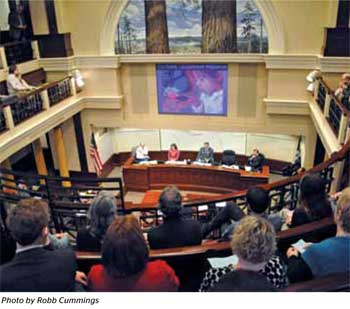
RACC’S MURAL PROGRAM
Adding to the City’s Canvas
PORTLANDERS MAY HAVE GRIPED through June-uary and the summer that never really heated up in 2011, but the break from the blazing sun made for a fine “mural season,” those prime months for painting large scale works of art, which often take several weeks to complete.
Five new murals began taking form last summer with help from RACC. At the Pal Do Korean Market, at Southeast 61st Avenue and Foster Road, Una Kim’s multicolored dragon slowly slithered its way through forest, sea, and sky on the market’s side. At North Interstate Avenue’s Trillium Charter School, artists Jesus Kobe and Margret Harburg worked with community members and students at five North Portland schools to develop a mural celebrating the Multnomah Youth Commission’s Children and Youth Bill of Rights and the history of African Americans and Native Americans in the area.
The once-blank east wall of the building that houses Pambiche, a Cuban restaurant on Northeast Glisan Street and 128th Avenue, is now a riot of color, covered in images of Cuban cultural and historical figures, all depicted in lively tropical hues. The four-story mural was designed by artists Emily Beeks and Rachel Oleson, in collaboration with Pambiche co-owner and chef John Connell-Maribona. Beeks also works as a server at the restaurant, which sponsored the project.
Other murals completed in 2011 include Citybikes, by Roger Peet at Southeast Seventh Avenue and Ankeny Street; She Flies With Her Own Wings, by Sharyn Smith with assistance from Alameda’s Kinderpainters, at Northeast 27th Avenue and Alameda Street; and History of Land Use in Hillsdale by Angelina Marino with assistance from Joel Heidel.
For projects like these, artists begin cultivating their ideas and planning their designs months in advance usually, working with community members, business and property owners, and sometimes students of all ages. Walls are then prepared and painted, which can be a taxing process, especially if it’s hot and sunny. It’s rarely a lonely task, though: conversations with passersby are often part of the project, with people offering up words of encouragement, opinions, and suggestions of what (else) to include in the painting. Seeing these works of art unfold over time down the block from where you live or shop can be inspiring and may even spur your own “artist within” to get cracking on a creative project.
To see the city’s entire collection of public art murals, visit racc.org/murals.
CITY FUNDING
State of the Arts
FOR THE THIRD consecutive year, arts advocates packed Council Chambers at Portland City Hall for RACC’s “State of the Arts” presentation on March 9. RACC staff and board members were joined by a Woodlawn elementary and Right Brain Initiative teacher, public art participants, and others to report on how City of Portland funds were invested in arts and culture the prior year, including project, general support, and opportunity grants. RACC Executive Director Eloise Damrosch noted that, taken together, the 44 organizations that received general support grants the previous year would be the region’s 25th largest employer.
The presentation included a performance by grant recipient PHAME Academy and a group sing-along as the arts community expressed its appreciation to a City Council that continues to be supportive of arts, culture, creativity, and innovation. RACC’s report to the council was accepted by a 5–0 vote.
PUBLIC ART MAINTENANCE
Staying In Shape
RACC CONTINUES TO devote substantial resources not just to funding new works of public art but to maintaining and preserving the existing public art collection in Portland and Multnomah County. Last year this included significant conservation work on two monumental historic bronze sculptures. One is Hermon Atkins MacNeil’s The Coming of the White Man, which has been weathering the elements in Washington Park since 1904, where it depicts two Native Americans facing east. The other is Gutzon Borglum’s 1933 statue of pioneer and Oregonian editor Harvey W. Scott atop Mt. Tabor Park. (Borglum is most famous as the chief sculptor of the faces on Mount Rushmore.) A matching grant from the Oregon Cultural Trust helped make the $8,000 restoration of Harvey Scott possible. These are just two of approximately 2,000 publicly owned artworks in the city and county that RACC is responsible for maintaining.

TECHNICAL ASSISTANCE
Class is in Session
MOST ARTISTS ARE not also accountants, lawyers, grant writers, industrial fabricators, or advertising professionals, and hiring people to perform a lot of these tasks on an artist’s behalf can certainly add up. That’s why RACC offers workshops that cover legal issues, grant writing, public art fabrication, marketing, and more. In 2011, more than 300 artists participated in the workshops, which aim to give individual artists new skills that will help them succeed in their craft, find a wider audience, access new opportunities, and generally take their work to the next level. In addition, RACC also provided in-depth technical assistance last year to arts organizations through the Cultural Leadership Program, which aids staff and boards in all aspects of organization development, including long-range planning and fundraising. A list of participating groups appears on page 24.
